Highly Efficient Liquid-Phase Exfoliation of Layered Perovskite-like Titanates HLnTiO4 and H2Ln2Ti3O10 (Ln = La, Nd) into Nanosheets
Abstract
1. Introduction
2. Materials and Methods
2.1. Synthesis of Initial Protonated Titanates
2.2. Synthesis of n-Alkylamine Derivatives
2.3. Optimization of the Exfoliation Procedure
2.4. Construction of Spectrophotometric Calibration Plots
2.5. Deposition of the Nanosheets on Substrates
2.6. Investigation of the Nanosheet Suspension Stability at Various pH
2.7. Instrumentation
2.7.1. XRD
2.7.2. ICP-AES
2.7.3. UV-Vis Spectrophotometry
2.7.4. DLS
2.7.5. TEM
2.7.6. SEM
2.7.7. AFM
2.7.8. pH Measurement
3. Results and Discussion
3.1. Identification of the Precursors for Exfoliation
3.2. Spectrophotometric Calibration Plots
3.3. Optimization of the Exfoliation Procedure
3.4. Investigation of the Nanosheet Morphology
3.5. Investigation of the Nanosheet Suspension Stability at Various pH
4. Conclusions
Supplementary Materials
Author Contributions
Funding
Data Availability Statement
Acknowledgments
Conflicts of Interest
References
- Hinterding, R.; Feldhoff, A. Two-Dimensional Oxides: Recent Progress in Nanosheets. Z. Phys. Chem. 2018, 233, 117–165. [Google Scholar] [CrossRef]
- Takagaki, A.; Tagusagawa, C.; Hayashi, S.; Hara, M.; Domen, K. Nanosheets as Highly Active Solid Acid Catalysts for Green Chemical Syntheses. Energy Environ. Sci. 2010, 3, 82–93. [Google Scholar] [CrossRef]
- Zhao, Y.; Zhang, S.; Shi, R.; Waterhouse, G.I.N.; Tang, J.; Zhang, T. Two-Dimensional Photocatalyst Design: A Critical Review of Recent Experimental and Computational Advances. Mater. Today 2020, 34, 78–91. [Google Scholar] [CrossRef]
- Le, T.B.N.; Chang, C.W.; Su, Y.H. Hydrogen Generation Ability of B-Site Substituted Two-Dimensional Can−1Tin−3Nb3O3n+1− Perovskite Nanosheets in Photoelectrochemical Cell. Surf. Interfaces 2023, 36, 102623. [Google Scholar] [CrossRef]
- Bi, D.; Tress, W.; Dar, M.I.; Gao, P.; Luo, J.; Renevier, C.; Schenk, K.; Abate, A.; Giordano, F.; Baena, J.C.; et al. Efficient Luminescent Solar Cells Based on Tailored Mixed-Cation Perovskites. Sci. Adv. 2016, 2, e1501170. [Google Scholar] [CrossRef] [PubMed]
- Zhong, C.; Deng, Y.; Hu, W.; Qiao, J.; Zhang, L.; Zhang, J. A Review of Electrolyte Materials and Compositions for Electrochemical Supercapacitors. Chem. Soc. Rev. 2015, 44, 7484–7539. [Google Scholar] [CrossRef] [PubMed]
- Koumoto, K.; Wang, Y.; Zhang, R.; Kosuga, A.; Funahashi, R. Oxide Thermoelectric Materials: A Nanostructuring Approach. Annu. Rev. Mater. Res. 2010, 40, 363–394. [Google Scholar] [CrossRef]
- Osada, M.; Sasaki, T. Exfoliated Oxide Nanosheets: New Solution to Nanoelectronics. J. Mater. Chem. 2009, 19, 2503–2511. [Google Scholar] [CrossRef]
- Huang, H.; Ying, Y.; Peng, X. Graphene Oxide Nanosheet: An Emerging Star Material for Novel Separation Membranes. J. Mater. Chem. A 2014, 2, 13772–13782. [Google Scholar] [CrossRef]
- Sun, L.; Fang, W.; Yang, Y.; Yu, H.; Wang, T.; Dong, X.; Liu, G.; Wang, J.; Yu, W.; Shi, K. Highly Active and Porous Single-Crystal In2O3 Nanosheet for NOx Gas Sensor with Excellent Response at Room Temperature. RSC Adv. 2017, 7, 33419–33425. [Google Scholar] [CrossRef]
- Ibrahim, M.A.A.; Hamad, M.H.A.; Mahmoud, A.H.M.; Mekhemer, G.A.H.; Sayed, S.R.M.; El-Rahman, M.K.A.; Sidhom, P.A.; Dabbish, E.; Shoeib, T. On the Use of Graphene Nanosheets for Drug Delivery: A Case Study of Cisplatin and Some of Its Analogs. Pharmaceutics 2023, 15, 1640. [Google Scholar] [CrossRef]
- Maeda, K. Photocatalytic Water Splitting Using Semiconductor Particles: History and Recent Developments. J. Photochem. Photobiol. C Photochem. Rev. 2011, 12, 237–268. [Google Scholar] [CrossRef]
- Schaak, R.E.; Mallouk, T.E. Perovskites by Design: A Toolbox of Solid-State Reactions. Chem. Mater. 2002, 14, 1455–1471. [Google Scholar] [CrossRef]
- Uppuluri, R.; Sen Gupta, A.; Rosas, A.S.; Mallouk, T.E. Soft Chemistry of Ion-Exchangeable Layered Metal Oxides. Chem. Soc. Rev. 2018, 47, 2401–2430. [Google Scholar] [CrossRef] [PubMed]
- Tani, S.; Komori, Y.; Hayashi, S.; Sugahara, Y. Local Environments and Dynamics of Hydrogen Atoms in Protonated Forms of Ion-Exchangeable Layered Perovskites Estimated by Solid-State 1H NMR. J. Solid State Chem. 2006, 179, 3357–3364. [Google Scholar] [CrossRef]
- Nishimoto, S.; Matsuda, M.; Miyake, M. Novel Protonated and Hydrated Ruddlesden–Popper Phases, HxNa1−xLaTiO4·yH2O, Formed by Ion-Exchange/Intercalation Reaction. J. Solid State Chem. 2005, 178, 811–818. [Google Scholar] [CrossRef]
- Nishimoto, S.; Matsuda, M.; Harjo, S.; Hoshikawa, A.; Kamiyama, T.; Ishigaki, T.; Miyake, M. Structure Determination of N = 1 Ruddlesden–Popper Compound HLaTiO4 by Powder Neutron Diffraction. J. Eur. Ceram. Soc. 2006, 26, 725–729. [Google Scholar] [CrossRef]
- Jacobson, A.J.; Lewandowski, J.T.; Johnson, J.W. Ion Exchange of the Layered Perovskite KCa2Nb3O10 by Protons. J. Less Common Met. 1986, 116, 137–146. [Google Scholar] [CrossRef]
- Jacobson, A.J.; Johnson, J.W.; Lewandowski, J.T. Interlayer Chemistry between Thick Transition-Metal Oxide Layers: Synthesis and Intercalation Reactions of K[Ca2Nan-3NbnO3+1] (3 ≤ n ≤ 7). Inorg. Chem. 1985, 24, 3727–3729. [Google Scholar] [CrossRef]
- Singh, S.J.; Jayaram, R.V. Chemoselective O-Tert-Butoxycarbonylation of Hydroxy Compounds Using NaLaTiO4 as a Heterogeneous and Reusable Catalyst. Tetrahedron Lett. 2008, 49, 4249–4251. [Google Scholar] [CrossRef]
- Campbell, K.D. Layered and Double Perovskites as Methane Coupling Catalysts. Catal. Today 1992, 13, 245–253. [Google Scholar] [CrossRef]
- Rodionov, I.A.; Zvereva, I.A. Photocatalytic Activity of Layered Perovskite-like Oxides in Practically Valuable Chemical Reactions. Russ. Chem. Rev. 2016, 85, 248–279. [Google Scholar] [CrossRef]
- Voytovich, V.V.; Kurnosenko, S.A.; Silyukov, O.I.; Rodionov, I.A.; Minich, I.A.; Zvereva, I.A. Study of N-Alkylamine Intercalated Layered Perovskite-like Niobates HCa2Nb3O10 as Photocatalysts for Hydrogen Production from an Aqueous Solution of Methanol. Front. Chem. 2020, 8, 300. [Google Scholar] [CrossRef]
- Voytovich, V.V.; Kurnosenko, S.A.; Silyukov, O.I.; Rodionov, I.A.; Bugrov, A.N.; Minich, I.A.; Malygina, E.N.; Zvereva, I.A. Synthesis of N-Alkoxy Derivatives of Layered Perovskite-like Niobate HCa2Nb3O10 and Study of Their Photocatalytic Activity for Hydrogen Production from an Aqueous Solution of Methanol. Catalysts 2021, 11, 897. [Google Scholar] [CrossRef]
- Rodionov, I.A.; Maksimova, E.A.; Pozhidaev, A.Y.; Kurnosenko, S.A.; Silyukov, O.I.; Zvereva, I.A. Layered Titanate H2Nd2Ti3O10 Intercalated with N-Butylamine: A New Highly Efficient Hybrid Photocatalyst for Hydrogen Production From Aqueous Solutions of Alcohols. Front. Chem. 2019, 7, 863. [Google Scholar] [CrossRef] [PubMed]
- Rodionov, I.A.; Gruzdeva, E.O.; Mazur, A.S.; Kurnosenko, S.A.; Silyukov, O.I.; Zvereva, I.A. Photocatalytic Hydrogen Generation from Aqueous Methanol Solution over n-Butylamine-Intercalated Layered Titanate H2La2Ti3O10: Activity and Stability of the Hybrid Photocatalyst. Catalysts 2022, 12, 1556. [Google Scholar] [CrossRef]
- Kurnosenko, S.A.; Voytovich, V.V.; Silyukov, O.I.; Rodionov, I.A.; Kirichenko, S.O.; Minich, I.A.; Malygina, E.N.; Khramova, A.D.; Zvereva, I.A. Photocatalytic Activity of N-Alkylamine and n-Alkoxy Derivatives of Layered Perovskite-like Titanates H2Ln2Ti3O10 (Ln = La, Nd) in the Reaction of Hydrogen Production from an Aqueous Solution of Methanol. Catalysts 2021, 11, 1279. [Google Scholar] [CrossRef]
- Kurnosenko, S.A.; Voytovich, V.V.; Silyukov, O.I.; Rodionov, I.A.; Zvereva, I.A. Photocatalytic Hydrogen Production from Aqueous Solutions of Glucose and Xylose over Layered Perovskite-like Oxides HCa2Nb3O10, H2La2Ti3O10 and Their Inorganic-Organic Derivatives. Nanomaterials 2022, 12, 2717. [Google Scholar] [CrossRef]
- Kurnosenko, S.A.; Voytovich, V.V.; Silyukov, O.I.; Rodionov, I.A.; Zvereva, I.A. Photocatalytic Activity and Stability of Organically Modified Layered Perovskite-like Titanates HLnTiO4 (Ln = La, Nd) in the Reaction of Hydrogen Evolution from Aqueous Methanol. Catalysts 2023, 13, 749. [Google Scholar] [CrossRef]
- Pradhan, D.K.; Samantaray, B.K.; Choudhary, R.N.P.; Thakur, A.K. Complex Impedance Studies on a Layered Perovskite Ceramic Oxide—NaNdTiO4. Mater. Sci. Eng. B 2005, 116, 7–13. [Google Scholar] [CrossRef]
- Thangadurai, V.; Shukla, A.; Gopalakrishnan, J. Proton Conduction in Layered Perovskite Oxides. Solid State Ion. 1994, 73, 9–14. [Google Scholar] [CrossRef]
- Toda, K.; Watanabeb, J.; Satob, M. Synthesis and Ionic Conductivity of New Layered Perovskite Compound, Ag2La2Ti3O10. Solid State Ionics 1996, 90, 15–19. [Google Scholar] [CrossRef]
- Byeon, S.; Kileung, P.; Park, K. Structure and Ionic Conductivity of NaLnTiO4, Comparison with Those of Na2Ln2Ti3O10 (Ln = La, Nd, Sm, and Gd). J. Solid State Chem. 1996, 121, 430–436. [Google Scholar] [CrossRef]
- Sato, M.; Abo, J.; Jin, T.; Ohta, M. Structure and Ionic Conductivity of MLaNb2O7 (M ≡ K, Na, Li, H). J. Alloys Compd. 1993, 192, 81–83. [Google Scholar] [CrossRef]
- Toda, K.; Suzuki, T.; Sato, M. Synthesis and High Ionic Conductivity of New Layered Perovskite Compounds, AgLaTa2O7 and AgCa2Ta3O10. Solid State Ionics 1997, 93, 177–181. [Google Scholar] [CrossRef]
- Toda, K.; Kurita, S.; Sato, M. Synthesis and Ionic Conductivity of Novel Layered Perovskite Compounds, AgLaTiO4 and AgEuTiO4. Solid State Ionics 1995, 81, 267–271. [Google Scholar] [CrossRef]
- Toda, K.; Kameo, Y.; Kurita, S.; Sato, M. Crystal Structure Determination and Ionic Conductivity of Layered Perovskite Compounds NaLnTiO4 (Ln = Rare Earth). J. Alloys Compd. 1996, 234, 19–25. [Google Scholar] [CrossRef]
- Sato, M.; Watanabe, J.; Kazuyoshi, U. Crystal Structure and Ionic Conductivity of a Layered-Perovskite AgLaNb2O7. J. Solid State Chem. 1993, 107, 460–470. [Google Scholar] [CrossRef]
- Zhang, N.; Guo, C.; Jing, H. Photoluminescence and Cathode-Luminescence of Eu3+-Doped NaLnTiO4 (Ln = Gd and Y) Phosphors. RSC Adv. 2013, 3, 7495. [Google Scholar] [CrossRef]
- Funatsu, A.; Taniguchi, T.; Tokita, Y.; Murakami, T.; Nojiri, Y.; Matsumoto, Y. Nd3+-Doped Perovskite Nanosheets with NIR Luminescence. Mater. Lett. 2014, 114, 29–33. [Google Scholar] [CrossRef][Green Version]
- Toda, K.; Honma, T.; Sato, M. Unusual Concentration Quenching of Europium Luminescence in New Layered Perovskite Compound, RbLa1−xEuxTa2O7 (0 ≤ x ≤ 1). J. Lumin. 1997, 71, 71–75. [Google Scholar] [CrossRef]
- Lin, L.; Yan, B. Rare Earth Titanates Ceramics Na2La2Ti3O10: Pr3+ and RE2Ti2O7: Pr3+ (R = Gd, Y): Sol–Gel Synthesis, Characterization and Luminescence. J. Mater. Sci. Mater. Electron. 2010, 22, 672–678. [Google Scholar] [CrossRef]
- Li, X.; Tian, Y.; Shen, R.; Li, X.; Xu, S.; Cheng, L.; Sun, J.; Zhang, J.; Zhang, X.; Chen, B. Sol-Gel Auto-Combustion Preparation and Photoluminescence Properties of Er3+-Doped K2La2Ti3O10 Phosphors with Superior Thermal Luminescence Stability. Colloids Surfaces A Physicochem. Eng. Asp. 2019, 578, 123595. [Google Scholar] [CrossRef]
- Ida, S.; Ogata, C.; Unal, U.; Izawa, K.; Inoue, T.; Altuntasoglu, O.; Matsumoto, Y. Preparation of a Blue Luminescent Nanosheet Derived from Layered Perovskite Bi2SrTa2O9. J. Am. Chem. Soc. 2007, 129, 8956–8957. [Google Scholar] [CrossRef]
- Cui, W.; Qi, Y.; Liu, L.; Rana, D.; Hu, J.; Liang, Y. Synthesis of PbS–K2La2Ti3O10 Composite and Its Photocatalytic Activity for Hydrogen Production. Prog. Nat. Sci. Mater. Int. 2012, 22, 120–125. [Google Scholar] [CrossRef][Green Version]
- Cui, W.; Liu, L.; Ma, S.; Liang, Y.; Zhang, Z. CdS-Sensitized K2La2Ti3O10 Composite: A New Photocatalyst for Hydrogen Evolution under Visible Light Irradiation. Catal. Today 2013, 207, 44–49. [Google Scholar] [CrossRef]
- Cui, W.; Guo, D.; Liu, L.; Hu, J.; Rana, D.; Liang, Y. Preparation of ZnIn2S4/K2La2Ti3O10 Composites and Their Photocatalytic H2 Evolution from Aqueous Na2S/Na2SO3 under Visible Light Irradiation. Catal. Commun. 2014, 48, 55–59. [Google Scholar] [CrossRef]
- Saito, K.; Kozeni, M.; Sohmiya, M.; Komaguchi, K.; Ogawa, M.; Sugahara, Y.; Ide, Y. Unprecedentedly Enhanced Solar Photocatalytic Activity of a Layered Titanate Simply Integrated with TiO2 Nanoparticles. Phys. Chem. Chem. Phys. 2016, 18, 30920–30925. [Google Scholar] [CrossRef]
- Liu, Y.; Zhou, Y.; Lv, C.; Zhang, C.; Jin, X.; Meng, Q.; Chen, G. Construction of 2D-Composite HCa2Nb3O10/CaNb2O6 Heterostructured Photocatalysts with Enhanced Hydrogen Production Performance. New J. Chem. 2018, 42, 681–687. [Google Scholar] [CrossRef]
- Zhang, L.; Wong, K.H.; Chen, Z.; Yu, J.C.; Zhao, J.; Hu, C.; Chan, C.Y.; Wong, P.K. AgBr-Ag-Bi2WO6 Nanojunction System: A Novel and Efficient Photocatalyst with Double Visible-Light Active Components. Appl. Catal. A Gen. 2009, 363, 221–229. [Google Scholar] [CrossRef]
- Kim, H.G.; Jeong, E.D.; Borse, P.H.; Jeon, S.; Yong, K.; Lee, J.S.; Li, W.; Oh, S.H. Photocatalytic Ohmic Layered Nanocomposite for Efficient Utilization of Visible Light Photons. Appl. Phys. Lett. 2006, 89, 2012–2015. [Google Scholar] [CrossRef]
- Zhang, L.; Wang, G.; Xiong, Z.; Tang, H.; Jiang, C. Fabrication of Flower-like Direct Z-Scheme β-Bi2O3/g-C3N4 photocatalyst with Enhanced Visible Light Photoactivity for Rhodamine B Degradation. Appl. Surf. Sci. 2018, 436, 162–171. [Google Scholar] [CrossRef]
- Tahara, S.; Sugahara, Y. Interlayer Surface Modification of the Protonated Triple-Layered Perovskite HCa2Nb3O10·xH2O with n-Alcohols. Langmuir 2003, 19, 9473–9478. [Google Scholar] [CrossRef]
- Tahara, S.; Ichikawa, T.; Kajiwara, G.; Sugahara, Y. Reactivity of the Ruddlesden−Popper Phase H2La2Ti3O10 with Organic Compounds: Intercalation and Grafting Reactions. Chem. Mater. 2007, 19, 2352–2358. [Google Scholar] [CrossRef]
- Jacobson, A.J.; Johnson, J.W.; Lewandowski, J. Intercalation of the Layered Solid Acid HCa2Nb3O10 by Organic Amines. Mater. Res. Bull. 1987, 22, 45–51. [Google Scholar] [CrossRef]
- Kurnosenko, S.A.; Silyukov, O.I.; Mazur, A.S.; Zvereva, I.A. Synthesis and Thermal Stability of New Inorganic-Organic Perovskite-like Hybrids Based on Layered Titanates HLnTiO4 (Ln = La, Nd). Ceram. Int. 2020, 46, 5058–5068. [Google Scholar] [CrossRef]
- Kurnosenko, S.A.; Voytovich, V.V.; Silyukov, O.I.; Minich, I.A.; Malygina, E.N.; Zvereva, I.A. Inorganic-Organic Derivatives of Layered Perovskite-like Titanates HLnTiO4 (Ln = La, Nd) with n-Amines and n-Alcohols: Synthesis, Thermal, Vacuum and Hydrolytic Stability. Ceram. Int. 2022, 48, 7240–7252. [Google Scholar] [CrossRef]
- Khramova, A.D.; Silyukov, O.I.; Kurnosenko, S.A.; Malygina, E.N.; Zvereva, I.A. Synthesis and Characterization of Inorganic-Organic Derivatives of Layered Perovskite-like Niobate HSr2Nb3O10 with n-Amines and n-Alcohols. Molecules 2023, 28, 4807. [Google Scholar] [CrossRef] [PubMed]
- Minich, I.A.; Silyukov, O.I.; Kurnosenko, S.A.; Gak, V.V.; Kalganov, V.D.; Kolonitskiy, P.D.; Zvereva, I.A. Physical–Chemical Exfoliation of n-Alkylamine Derivatives of Layered Perovskite-like Oxide H2K0.5Bi2.5Ti4O13 into Nanosheets. Nanomaterials 2021, 11, 2708. [Google Scholar] [CrossRef] [PubMed]
- Shiroma, Y.; Mogi, H.; Mashiko, T.; Yasuda, S.; Nishioka, S.; Yokoi, T.; Ida, S.; Kimoto, K.; Maeda, K. Interlayer Modification and Single-Layer Exfoliation of the Ruddlesden-Popper Perovskite Oxynitride K2LaTa2O6N to Improve Photocatalytic H2 Evolution Activity. J. Mater. Chem. A 2023, 10, 9485–9492. [Google Scholar] [CrossRef]
- Takagaki, A.; Sugisawa, M.; Lu, D.; Kondo, J.N.; Hara, M.; Domen, K.; Hayashi, S. Exfoliated Nanosheets as a New Strong Solid Acid Catalyst. J. Am. Chem. Soc. 2003, 125, 5479–5485. [Google Scholar] [CrossRef] [PubMed]
- Maeda, K.; Mallouk, T.E. Two-Dimensional Metal Oxide Nanosheets as Building Blocks for Artificial Photosynthetic Assemblies. Bull. Chem. Soc. Jpn. 2018, 92, 38–54. [Google Scholar] [CrossRef]
- Chen, Y.; Zhou, S.; Yang, X.; Ou-Yang, Y. Structural and Optical Properties of ZnS/Niobate Composites Synthesized by Exfoliation/Self-Assembly Processing. J. Solid State Chem. 2010, 183, 823–828. [Google Scholar] [CrossRef]
- Chen, Y.; Zhou, S.; Yang, X. Structure and Optical Property of CdS/Niobate Composite Synthesized by Exfoliation/Self-Assembly Processing. J. Non-Cryst. Solids 2010, 356, 1272–1276. [Google Scholar] [CrossRef]
- Chen, Y.; Zhao, X.; Ma, H.; Ma, S.; Huang, G.; Makita, Y.; Bai, X.; Yang, X. Structure and Dehydration of Layered Perovskite Niobate with Bilayer Hydrates Prepared by Exfoliation/Self-Assembly Process. J. Solid State Chem. 2008, 181, 1684–1694. [Google Scholar] [CrossRef]
- Zhang, Z.; Wang, D.; Yang, M.; Liu, L.; Ma, J.; Wang, M.; Zhang, C.; Zhang, D.; Tong, Z. Electrostatic Self-Assembly Deposition of Layered Calcium Niobate Intercalated with Task-Specific Ionic Liquid and Its Electrocatalytic Activity. Chem. Lett. 2017, 46, 506–508. [Google Scholar] [CrossRef]
- Nicolosi, V.; Chhowalla, M.; Kanatzidis, M.G.; Strano, M.S.; Coleman, J.N. Liquid Exfoliation of Layered Materials. Science 2013, 340, 1226419. [Google Scholar] [CrossRef]
- Hu, Y.; Mao, L.; Guan, X.; Tucker, K.A.; Xie, H.; Wu, X.; Shi, J. Layered Perovskite Oxides and Their Derivative Nanosheets Adopting Different Modification Strategies towards Better Photocatalytic Performance of Water Splitting. Renew. Sustain. Energy Rev. 2020, 119, 109527. [Google Scholar] [CrossRef]
- Akbarian-Tefaghi, S.; Rostamzadeh, T.; Brown, T.T.; Davis-Wheeler, C.; Wiley, J.B. Rapid Exfoliation and Surface Tailoring of Perovskite Nanosheets via Microwave-Assisted Reactions. ChemNanoMat 2017, 3, 538–550. [Google Scholar] [CrossRef]
- Payet, F.; Bouillet, C.; Leroux, F.; Leuvrey, C.; Rabu, P.; Schosseler, F.; Taviot-Guého, C.; Rogez, G. Fast and Efficient Shear-Force Assisted Production of Covalently Functionalized Oxide Nanosheets. J. Colloid Interface Sci. 2022, 607, 621–632. [Google Scholar] [CrossRef]
- Hou, W.; Kang, L.; Sun, R.; Liu, Z.H. Exfoliation of Layered Double Hydroxides by an Electrostatic Repulsion in Aqueous Solution. Colloids Surf. A Physicochem. Eng. Asp. 2008, 312, 92–98. [Google Scholar] [CrossRef]
- Han, Y.-S.; Park, I.; Choy, J.-H. Exfoliation of Layered Perovskite, KCa2Nb3O10, into Colloidal Nanosheets by a Novel Chemical Process. J. Mater. Chem. 2001, 11, 1277–1282. [Google Scholar] [CrossRef]
- Byeon, S.; Yoon, J.-J.; Lee, S.-O. A New Family of Protonated Oxides HLnTiO4 (Ln = La, Nd, Sm, and Gd). J. Solid State Chem. 1996, 127, 119–122. [Google Scholar] [CrossRef]
- Gopalakrishnan, J.; Bhat, V. A2Ln2Ti3O10 (A = Potassium or Rubidium; Ln = Lanthanum or Rare Earth): A New Series of Layered Perovskites Exhibiting Ion Exchange. Inorg. Chem. 1987, 26, 4299–4301. [Google Scholar] [CrossRef]
- Reddy, V.; Hwang, D.; Lee, J. Effect of Zr Substitution for Ti in KLaTiO4 for Photocatalytic Water Splitting. Catal. Lett. 2003, 90, 39–44. [Google Scholar] [CrossRef]
- Kawashima, K.; Hojamberdiev, M.; Chen, S.; Yubuta, K.; Wagata, H.; Domen, K.; Teshima, K. Understanding the Effect of Partial N3−-to-O2− Substitution and H+-to-K+ Exchange on Photocatalytic Water Reduction Activity of Ruddlesden–Popper Layered Perovskite KLaTiO4. Mol. Catal. 2017, 432, 250–258. [Google Scholar] [CrossRef]
- Takata, T.; Shinohara, K.; Tanaka, A.; Hara, M.; Kondo, J.N.; Domen, K. A Highly Active Photocatalyst for Overall Water Splitting with a Hydrated Layered Perovskite Structure. J. Photochem. Photobiol. A Chem. 1997, 106, 45–49. [Google Scholar] [CrossRef]
- Cui, W.; Liu, L.; Feng, L.; Xu, C.; Li, Z.; Lü, S.; Qiu, F. Preparation of Pt/K2La2Ti3O10 and Its Photo-Catalytic Activity for Hydrogen Evolution from Methanol Water Solution. Sci. China Ser. B 2006, 49, 162–168. [Google Scholar] [CrossRef]
- Tai, Y.-W.; Chen, J.-S.; Yang, C.-C.; Wan, B.-Z. Preparation of Nano-Gold on K2La2Ti3O10 for Producing Hydrogen from Photo-Catalytic Water Splitting. Catal. Today 2004, 97, 95–101. [Google Scholar] [CrossRef]
- Thaminimulla, C. Effect of Chromium Addition for Photocatalytic Overall Water Splitting on Ni–K2La2Ti3O10. J. Catal. 2000, 196, 362–365. [Google Scholar] [CrossRef]
- Ya-Hui, Y.; Qi-Yuan, C.; Zhou-Lan, Y.; Jie, L. Study on the Photocatalytic Activity of K2La2Ti3O10 Doped with Zinc(Zn). Appl. Surf. Sci. 2009, 255, 8419–8424. [Google Scholar] [CrossRef]
- Huang, Y.; Wu, J.; Wei, Y.; Hao, S.; Huang, M.; Lin, J. Synthesis and Photocatalytic Activity of Hydrated Layered Perovskite K2−xLa2Ti3−xNbxO10 (X = 0–1) and Protonated Derivatives. Scr. Mater. 2007, 57, 437–440. [Google Scholar] [CrossRef]
- Ida, S.; Ogata, C.; Eguchi, M.; Youngblood, W.J.; Mallouk, T.E.; Matsumoto, Y. Photoluminescence of Perovskite Nanosheets Prepared by Exfoliation of Layered Oxides, K2Ln2Ti3O10, KLnNb2O7, and RbLnTa2O7 (Ln: Lanthanide Ion). J. Am. Chem. Soc. 2008, 130, 7052–7059. [Google Scholar] [CrossRef] [PubMed]
- Schaak, R.E.; Mallouk, T.E. Prying Apart Ruddlesden-Popper Phases: Exfoliation into Sheets and Nanotubes for Assembly of Perovskite Thin Films. Solid State Ion. 2000, 12, 3427–3434. [Google Scholar] [CrossRef]
- Kawashima, K.; Hojamberdiev, M.; Wagata, H.; Yubuta, K.; Domen, K.; Teshima, K. Protonated Oxide, Nitrided, and Reoxidized K2La2Ti3O10 Crystals: Visible-Light-Induced Photocatalytic Water Oxidation and Fabrication of Their Nanosheets. ACS Sustain. Chem. Eng. 2017, 5, 232–240. [Google Scholar] [CrossRef]
- Kurnosenko, S.A.; Silyukov, O.I.; Minich, I.A.; Zvereva, I.A. Exfoliation of Methylamine and N-Butylamine Derivatives of Layered Perovskite-Like Oxides HLnTiO4 and H2Ln2Ti3O10 (Ln = La, Nd) into Nanolayers. Glas. Phys. Chem. 2021, 47, 372–381. [Google Scholar] [CrossRef]
- Yuan, H.; Nguyen, M.; Hammer, T.; Koster, G.; Rijnders, G.; Ten Elshof, J.E. Synthesis of KCa2Nb3O10 Crystals with Varying Grain Sizes and Their Nanosheet Monolayer Films As Seed Layers for PiezoMEMS Applications. ACS Appl. Mater. Interfaces 2015, 7, 27473–27478. [Google Scholar] [CrossRef]
- Xu, F.F.; Ebina, Y.; Bando, Y.; Sasaki, T. Structural Characterization of (TBA, H)Ca2Nb3O10 Nanosheets Formed by Delamination of a Precursor-Layered Perovskite. J. Phys. Chem. B 2003, 107, 9638–9645. [Google Scholar] [CrossRef]
- Xu, J.; Xia, B.; Wang, M.; Fan, Z.; Zhang, X.; Ma, J.; Liu, L.; Zhang, B.; Zhang, D.; Tong, Z. A Biosensor Consisting of Ca2Nb3O10− Substrates and Functional Molecule Manganese Porphyrins (MnTMPyP) Utilized for the Determinations of Nitrite. Funct. Mater. Lett. 2018, 11, 1850053. [Google Scholar] [CrossRef]
- Ohisa, S.; Hikichi, T.; Pu, Y.J.; Chiba, T.; Kido, J. Two-Dimensional Ca2Nb3O10 Perovskite Nanosheets for Electron Injection Layers in Organic Light-Emitting Devices. ACS Appl. Mater. Interfaces 2018, 10, 27885–27893. [Google Scholar] [CrossRef]
- Hojamberdiev, M.; Bekheet, M.F.; Zahedi, E.; Wagata, H.; Kamei, Y.; Yubuta, K.; Gurlo, A.; Matsushita, N.; Domen, K.; Teshima, K. New Dion-Jacobson Phase Three-Layer Perovskite CsBa2Ta3O10 and Its Conversion to Nitrided Ba2Ta3O10 Nanosheets via a Nitridation-Protonation-Intercalation-Exfoliation Route for Water Splitting. Cryst. Growth Des. 2016, 16, 2302–2308. [Google Scholar] [CrossRef]
- Wang, T.H.; Henderson, C.N.; Draskovic, T.I.; Mallouk, T.E. Synthesis, Exfoliation, and Electronic/Protonic Conductivity of the Dion-Jacobson Phase Layer Perovskite HLa2TiTa2O10. Chem. Mater. 2014, 26, 898–906. [Google Scholar] [CrossRef]
- Sakaki, M.; Feng, Y.Q.; Kajiyoshi, K. Ultrasonic-Assisted Exfoliation of Ca2Nb3O10− Nano-Sheets. J. Solid State Chem. 2019, 277, 253–259. [Google Scholar] [CrossRef]
- Kurnosenko, S.A.; Voytovich, V.V.; Silyukov, O.I.; Rodionov, I.A.; Malygina, E.N.; Zvereva, I.A. Influence of HB2Nb3O10-Based Nanosheet Photocatalysts (B = Ca, Sr) Preparation Method on Hydrogen Production Efficiency. Catalysts 2023, 13, 614. [Google Scholar] [CrossRef]
- Oshima, T.; Nishioka, S.; Kikuchi, Y.; Hirai, S.; Yanagisawa, K.I.; Eguchi, M.; Miseki, Y.; Yokoi, T.; Yui, T.; Kimoto, K.; et al. An Artificial Z-Scheme Constructed from Dye-Sensitized Metal Oxide Nanosheets for Visible Light-Driven Overall Water Splitting. J. Am. Chem. Soc. 2020, 142, 8412–8420. [Google Scholar] [CrossRef]
- Nishioka, S.; Hojo, K.; Xiao, L.; Gao, T.; Miseki, Y.; Yasuda, S.; Yokoi, T.; Sayama, K.; Mallouk, T.E.; Maeda, K. Surface-Modified, Dye-Sensitized Niobate Nanosheets Enabling an Efficient Solar-Driven Z-Scheme for Overall Water Splitting. Sci. Adv. 2022, 8, eadc9115. [Google Scholar] [CrossRef]
- Hu, Y.; Guo, L. Rapid Preparation of Perovskite Lead Niobate Nanosheets by Ultrasonic-Assisted Exfoliation for Enhanced Visible-Light-Driven Photocatalytic Hydrogen Production. ChemCatChem 2015, 7, 584–587. [Google Scholar] [CrossRef]
- Zhou, H.; Sabio, E.M.; Townsend, T.K.; Fan, T.; Zhang, D.; Osterloh, F.E. Assembly of Core-Shell Structures for Photocatalytic Hydrogen Evolution from Aqueous Methanol. Chem. Mater. 2010, 22, 3362–3368. [Google Scholar] [CrossRef]
- Hu, Y.; Li, G.; Zong, S.; Shi, J.; Guo, L. Self-Assembled Nanohybrid of Cadmium Sulfide and Calcium Niobate: Photocatalyst with Enhanced Charge Separation for Efficient Visible Light Induced Hydrogen Generation. Catal. Today 2018, 315, 117–125. [Google Scholar] [CrossRef]
- Jiang, D.; Wang, T.; Xu, Q.; Li, D.; Meng, S.; Chen, M. Perovskite Oxide Ultrathin Nanosheets/g-C3N4 2D-2D Heterojunction Photocatalysts with Significantly Enhanced Photocatalytic Activity towards the Photodegradation of Tetracycline. Appl. Catal. B Environ. 2017, 201, 617–628. [Google Scholar] [CrossRef]
- Ding, Y.; Luo, D.; Huang, Y.; Rong, B.; Chen, X.; Wei, Y.; Fan, L.; Wu, J. Microwave-Mechanochemistry-Assisted Synthesis of Z-Scheme HSr2Nb3O10/WO3 Heterojunctions for Improved Simulated Sunlight Driven Photocatalytic Activity. J. Environ. Chem. Eng. 2021, 9, 104624. [Google Scholar] [CrossRef]
- Zhang, S.; Diehl, L.; Wrede, S.; Lotsch, B.V.; Christina, S. Structural Evolution of Ni-Based Co-Catalysts on [Ca2Nb3O10]− Nanosheets during Heating and Their Photocatalytic Properties. Catalysts 2008, 10, 13. [Google Scholar] [CrossRef]
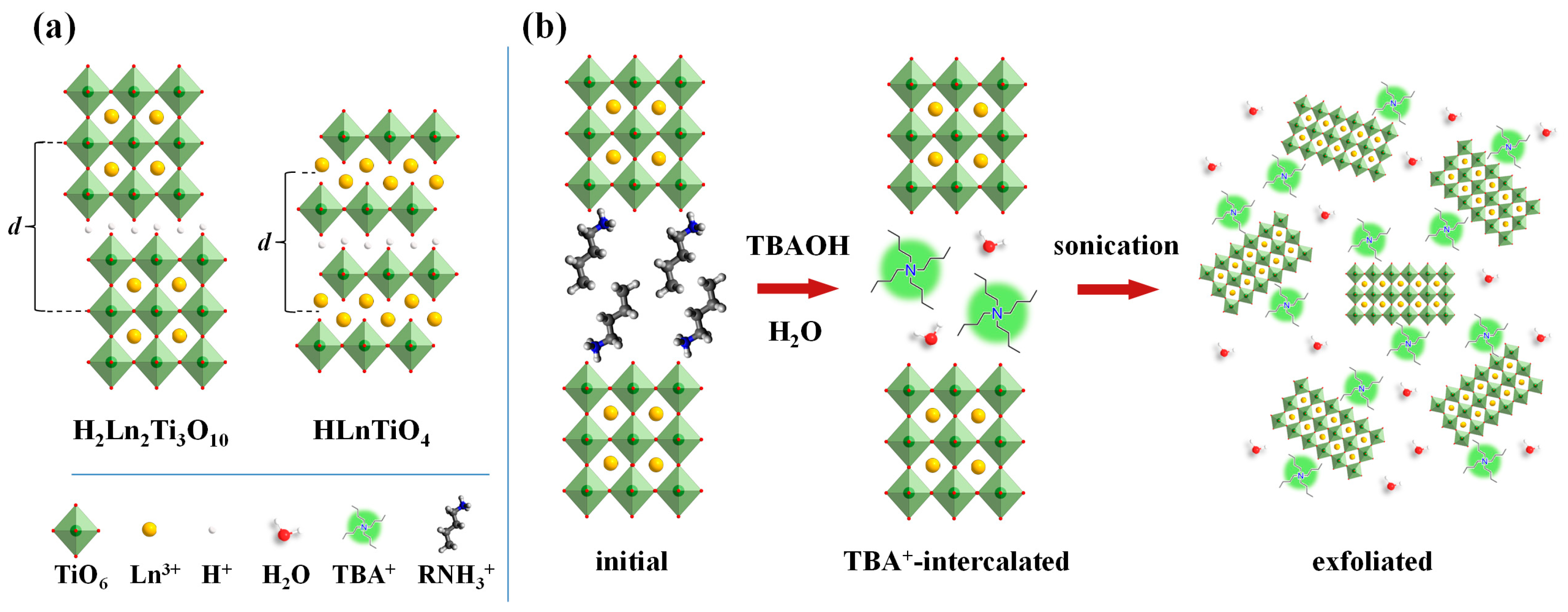

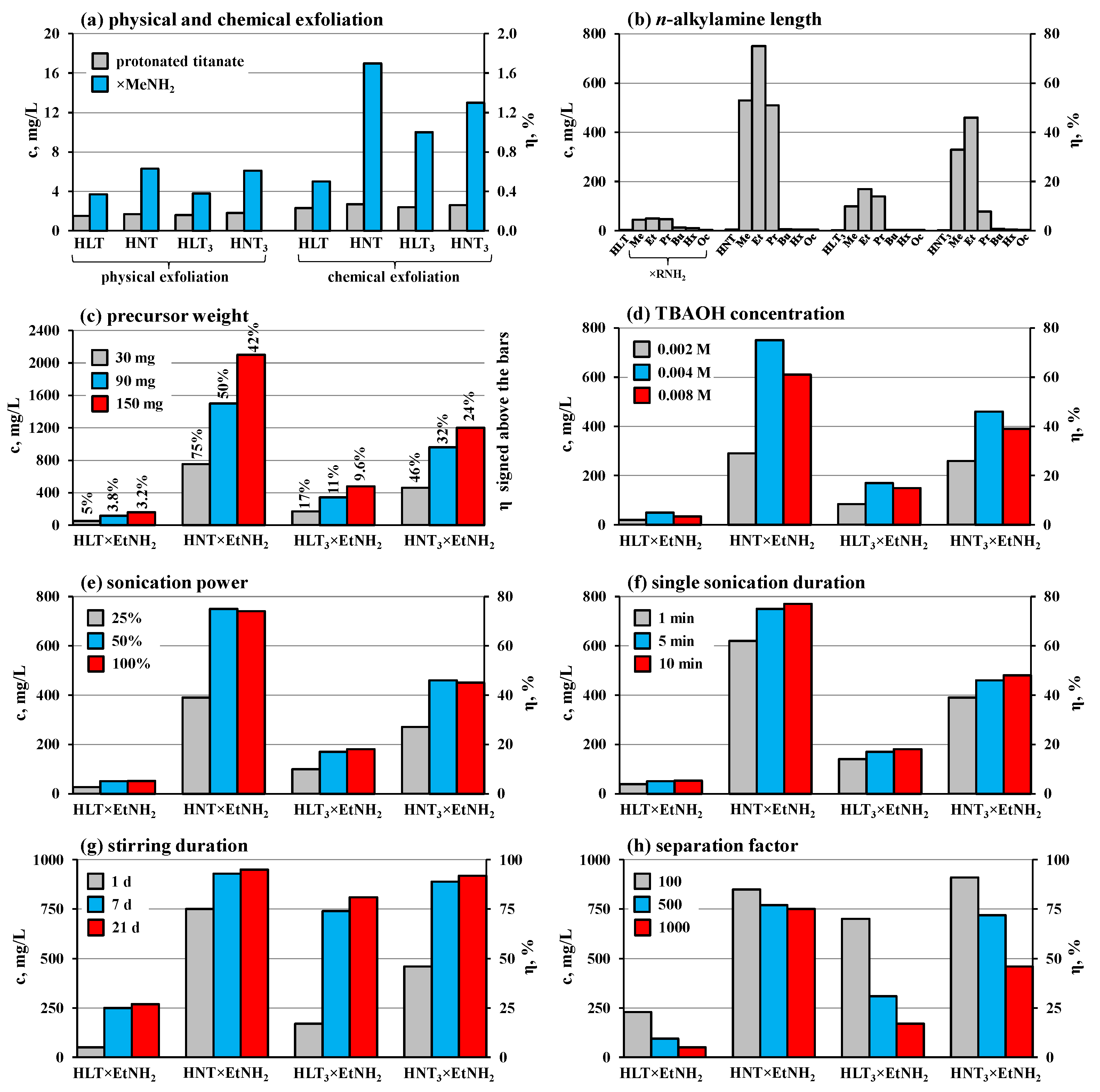
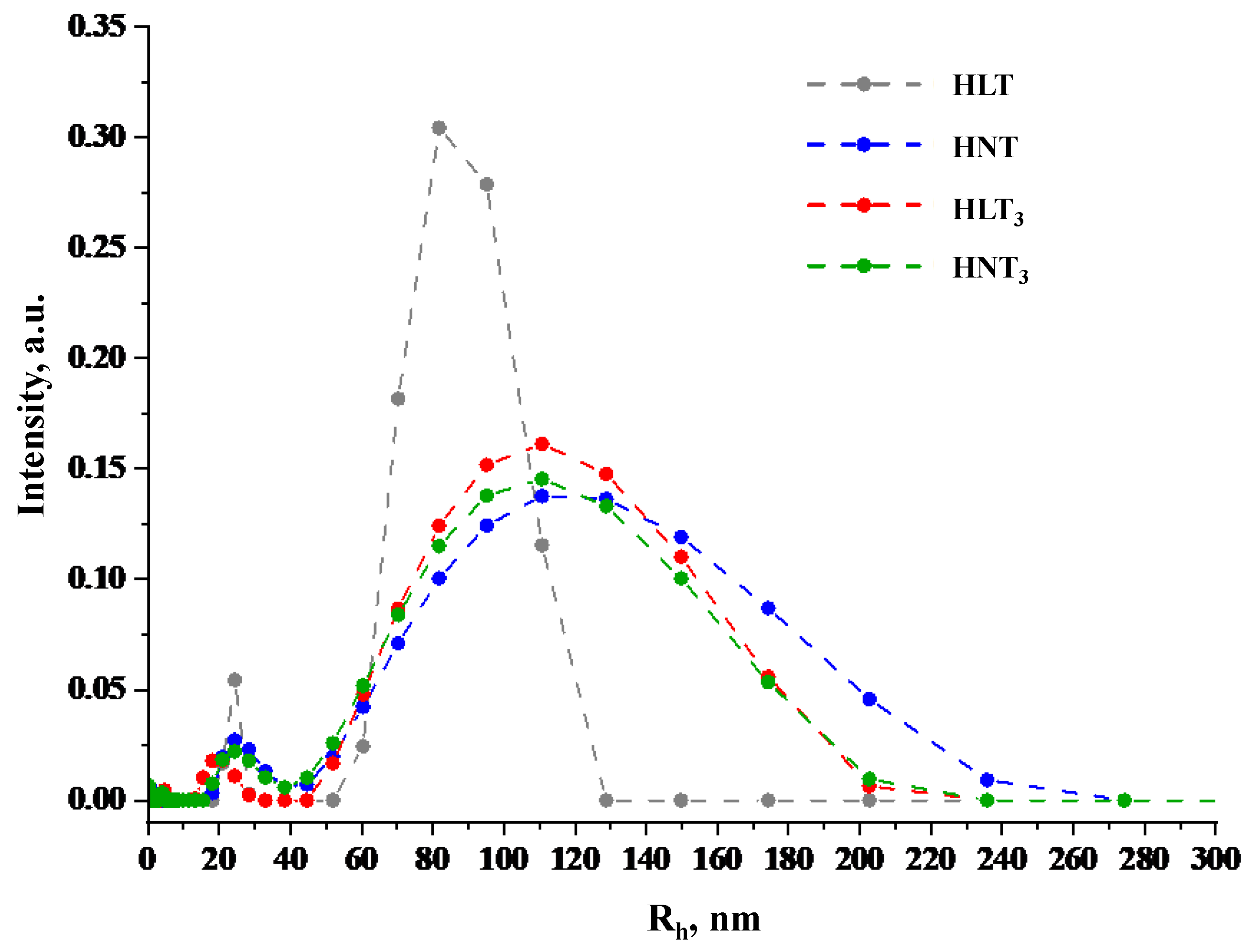

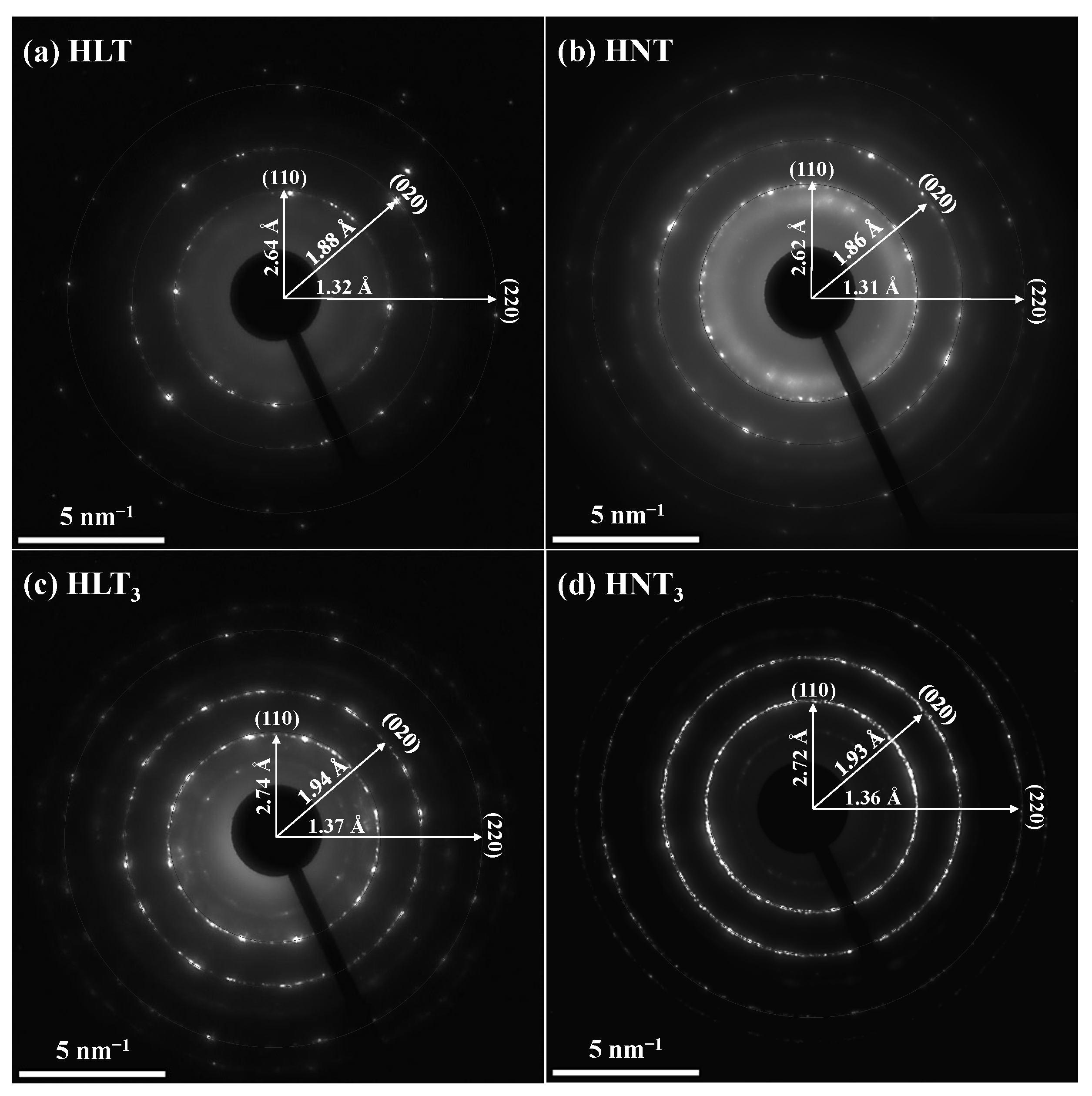
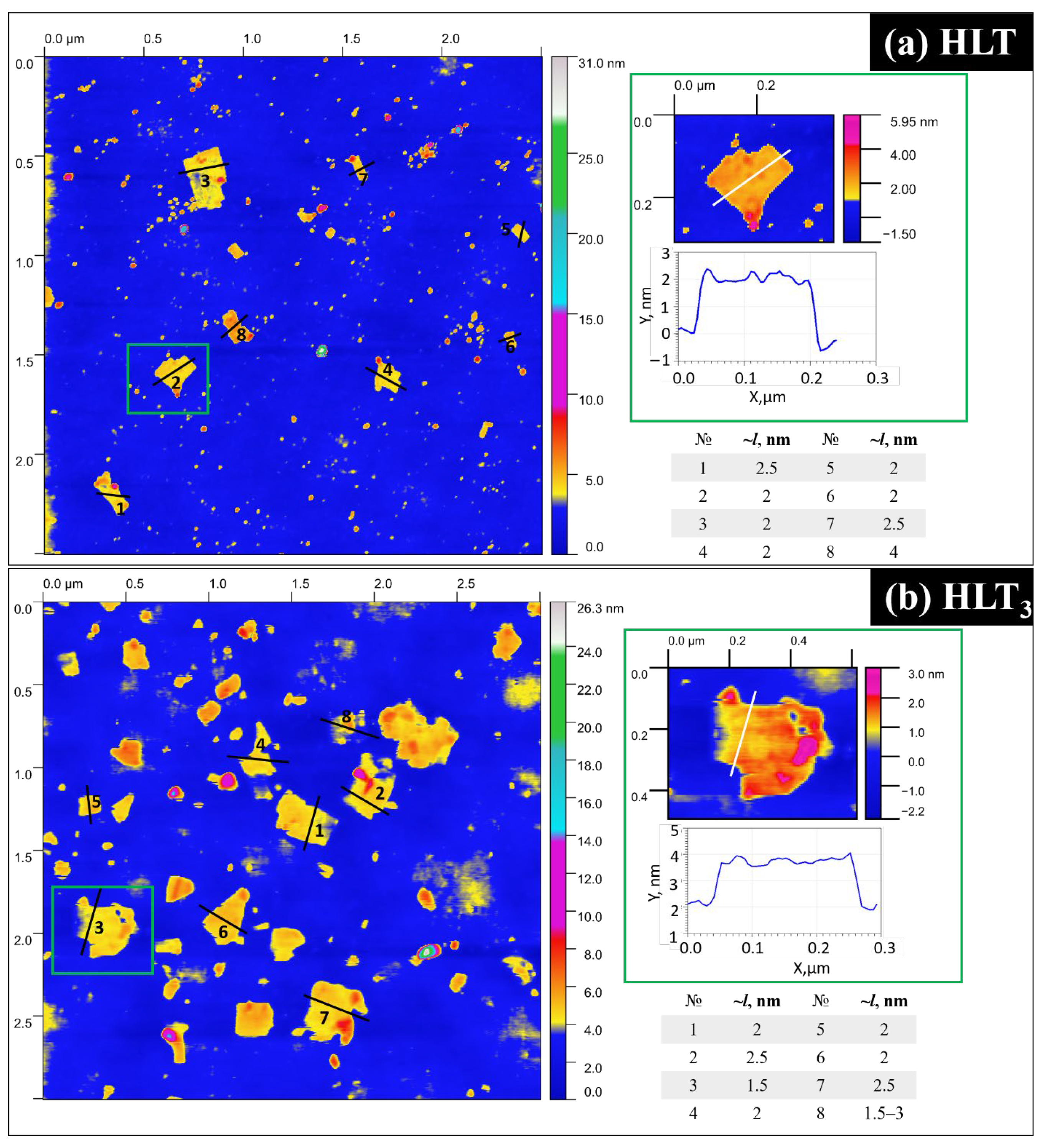
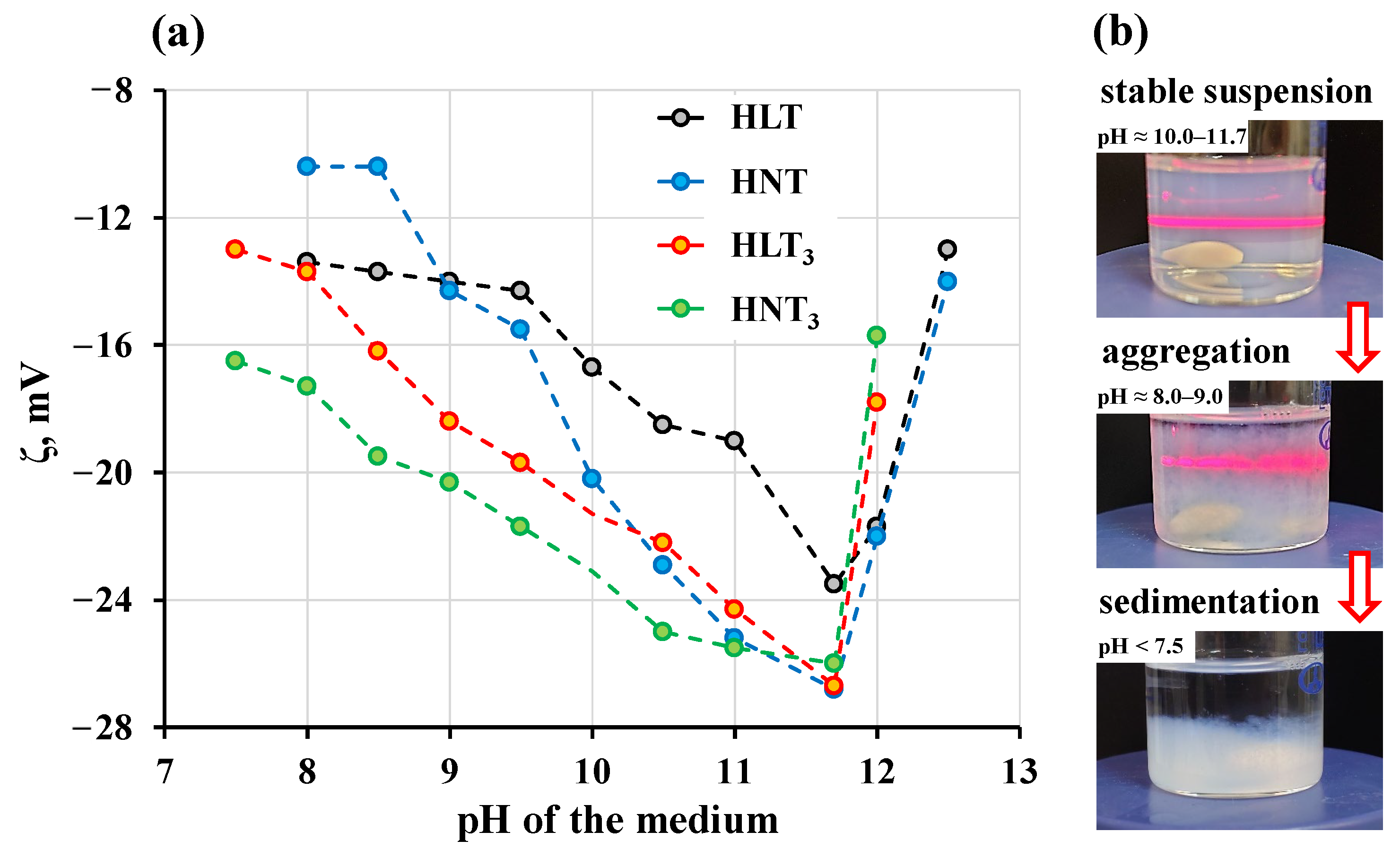
| R | Precursors | Amine Concentration, % | T, °C | D, d | Solvent for Flushing |
|---|---|---|---|---|---|
| Me | HLT (HNT), HLT3 (HNT3) | 38 (in water) | 60 | 10 | acetone |
| Et | HLT×MeNH2 (HNT×MeNH2), HLT3×MeNH2 (HNT3×MeNH2) | 70 (in water) | 25 | 1 | |
| Pr | 90 (in water) | ||||
| Bu | |||||
| Hx | 30 (in n-heptane) | 60 | 7 | n-hexane | |
| Oc |
| Experiment Series | Precursor | Weight, mg | TBAOH, M | Sonication | Stirring, d | Separation Factor | |
|---|---|---|---|---|---|---|---|
| Power, % | Duration, min | ||||||
| Physical exfoliation | HLT, HLT3 | 30 | - | 100 | 5 | 1 | 1000 |
| ×MeNH2 | |||||||
| Chemical exfoliation | HLT, HLT3 | 30 | 0.004 | − | − | 1 | 1000 |
| ×MeNH2 | |||||||
| Physical–chemical exfoliation | HLT, HLT3 | 30 | 0.004 | 50 | 5 | 1 | 1000 |
| ×MeNH2 | |||||||
| ×EtNH2 | |||||||
| ×PrNH2 | |||||||
| ×BuNH2 | |||||||
| ×HxNH2 | |||||||
| ×OcNH2 | |||||||
| Precursor weight | ×EtNH2 | 30 | 0.004 | 50 | 5 | 1 | 1000 |
| 90 | 0.012 | ||||||
| 150 | 0.02 | ||||||
| TBAOH concentration | 30 | 0.002 | 50 | 5 | 1 | 1000 | |
| 0.004 | |||||||
| 0.008 | |||||||
| Sonication power | 30 | 0.004 | 25 | 5 | 1 | 1000 | |
| 50 | |||||||
| 100 | |||||||
| Sonication duration | 30 | 0.004 | 50 | 1 | 1 | 1000 | |
| 5 | |||||||
| 10 | |||||||
| Stirring duration | 30 | 0.004 | 50 | 5 | 1 | 1000 | |
| 7 | |||||||
| 21 | |||||||
| Separation factor | 30 | 0.004 | 50 | 5 | 1 | 100 | |
| 500 | |||||||
| 1000 | |||||||
Disclaimer/Publisher’s Note: The statements, opinions and data contained in all publications are solely those of the individual author(s) and contributor(s) and not of MDPI and/or the editor(s). MDPI and/or the editor(s) disclaim responsibility for any injury to people or property resulting from any ideas, methods, instructions or products referred to in the content. |
© 2023 by the authors. Licensee MDPI, Basel, Switzerland. This article is an open access article distributed under the terms and conditions of the Creative Commons Attribution (CC BY) license (https://creativecommons.org/licenses/by/4.0/).
Share and Cite
Kurnosenko, S.A.; Minich, I.A.; Silyukov, O.I.; Zvereva, I.A. Highly Efficient Liquid-Phase Exfoliation of Layered Perovskite-like Titanates HLnTiO4 and H2Ln2Ti3O10 (Ln = La, Nd) into Nanosheets. Nanomaterials 2023, 13, 3052. https://doi.org/10.3390/nano13233052
Kurnosenko SA, Minich IA, Silyukov OI, Zvereva IA. Highly Efficient Liquid-Phase Exfoliation of Layered Perovskite-like Titanates HLnTiO4 and H2Ln2Ti3O10 (Ln = La, Nd) into Nanosheets. Nanomaterials. 2023; 13(23):3052. https://doi.org/10.3390/nano13233052
Chicago/Turabian StyleKurnosenko, Sergei A., Iana A. Minich, Oleg I. Silyukov, and Irina A. Zvereva. 2023. "Highly Efficient Liquid-Phase Exfoliation of Layered Perovskite-like Titanates HLnTiO4 and H2Ln2Ti3O10 (Ln = La, Nd) into Nanosheets" Nanomaterials 13, no. 23: 3052. https://doi.org/10.3390/nano13233052
APA StyleKurnosenko, S. A., Minich, I. A., Silyukov, O. I., & Zvereva, I. A. (2023). Highly Efficient Liquid-Phase Exfoliation of Layered Perovskite-like Titanates HLnTiO4 and H2Ln2Ti3O10 (Ln = La, Nd) into Nanosheets. Nanomaterials, 13(23), 3052. https://doi.org/10.3390/nano13233052







